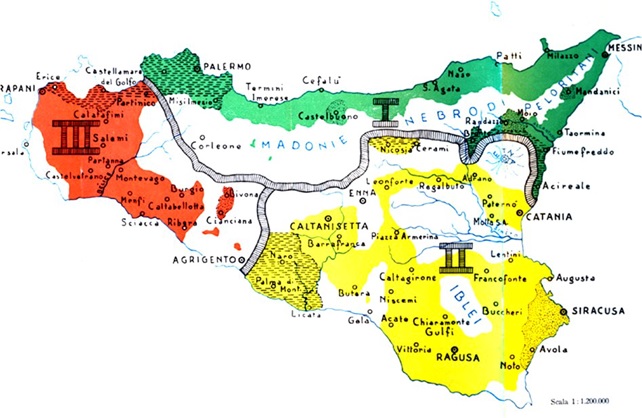Olive Biodiversity

Figure 1.1. Limit of the areas of diffusion of the main varieties. Variety area ‘Ogliarola Messinese’, ’Santagatese’, ‘Minuta’ (I). Area delle varietà ’Moresca‘, ‘Nocellara Etnea’, ‘Tonda Iblea’, ‘Biancolilla’ (II). Area delle varietà ‘Cerasuola’, ‘Nocellara del Belice’, ‘Buscionetto’, ‘Giaraffa’ (III).
- BIANCOLILLA: refers to a population of genotypes originating in western Sicily. The name derives from the whitish color that turns to lilac of the drupe during veraison. This cultivar exclusively used for oil extraction, has a low yield, but produces a highly appreciated oil. Great vigor plant with not well defined habit. The leaves are short and lanceolate, dark green in color, the little finger is sparse short. The fruit is large (4.5g) of elliptical and umbonate shape, with an excellent percentage of the weight of the pulp, about 85%, compared to that of the entire drupe. Production is often alternating and shows exceptional vintages. Biancolilla is partially self-fertile, however pollination is increased by Moresca, Nocellara Etnea, Zaituna, Ogliarola Messinese and Tonda Iblea (Bottari and Spina, 1952).
- CERASUOLA: cultivar of western Sicily known by different names (Palermitana, Marfia, Ogliara), is a variety sensitive to mange, with a high oil yield. The leaves are medium long elliptical lanceolate, the little finger is compact of medium length. The veraison starts from the base. The fruit has an average weight (4.3 g) of an elliptical shape, has small lenticels. The veraison starts from the apex.
- MORESCA: The name derives from the black color which it assumes early ripening already in October. It is grown for the extraction of oil with an average oil yield of about 16-19% and for direct consumption, concerning the production of dried black olives. The plant has an expanded habit with long internode twigs. The leaves are medium in length and rather broad, therefore elliptical in shape, the little finger is compact and short. The medium-weight fruit has an elliptical shape, has numerous large lenticels and the umbo. The veraison progresses from the base. La Moresca is self-sterile, but is usually fertilized by Biancolilla, Nocellara Etnea, Zaituna, Ogliarola Messinese and Tonda iblea (Bottari and Spina, 1952).
- NOCELLARA DEL BELICE: cultivar native to the Belice Valley and widespread in western Sicily. It produces oil and olives for direct consumption. The oil yield is medium, the elliptical leaves are lanceolate, the little finger is sparse of medium length. The fruit is heavy (7.4g) spherical in shape, umboned with a few large lenticels. The veraison is uniform.
- NOCELLARA ETNEA: original and widespread accession in eastern Sicily. With a dual attitude, the late ripening fruit is easily pitted, therefore it is suitable for the production of stuffed green olives, has an excellent kernel pulp ratio and the average oil yield is 15-20%. The plant is very vigorous with a thick crown with a pendulous posture and long internodes. The leaves are medium length lanceolate, the little finger is compact. The medium-high fruit shows an elongated shape, umbonate has few large lenticels. Among the Sicilian cultivars, the fruits of this variety are the least damaged by dacian attacks. The veraison is uniform. The Nocellara Etnea turns out to be self and often inter sterile, the main pollinators are Biancolilla and Moresca (Bottari and Spina, 1952).
TONDA IBLEA: cultivated in the province of Ragusa, Siracusa Catania, and Enna, it is used as a dual-purpose cultivar, for the preparation of green olives, given the excellent kernel pulp ratio, with pulp percentage values that are around 90%; on the other hand, the oil yield is average. The plant, with an upright bearing, has several xerophytic adaptations: the internodes, in fact, are short, the leaves short, lanceolate, with flaps folded towards the lower page, the little finger is also compact. The fruit is heavy in spherical or elliptical shape, has no umbo and little is the number of lenticels. The veraison progresses from the apex. It is an auto and often inter sterile cultivar, among the main pollinators there are Moresca, Zaituna and Calatina for the high hills (Bottari and Spina, 1952).

